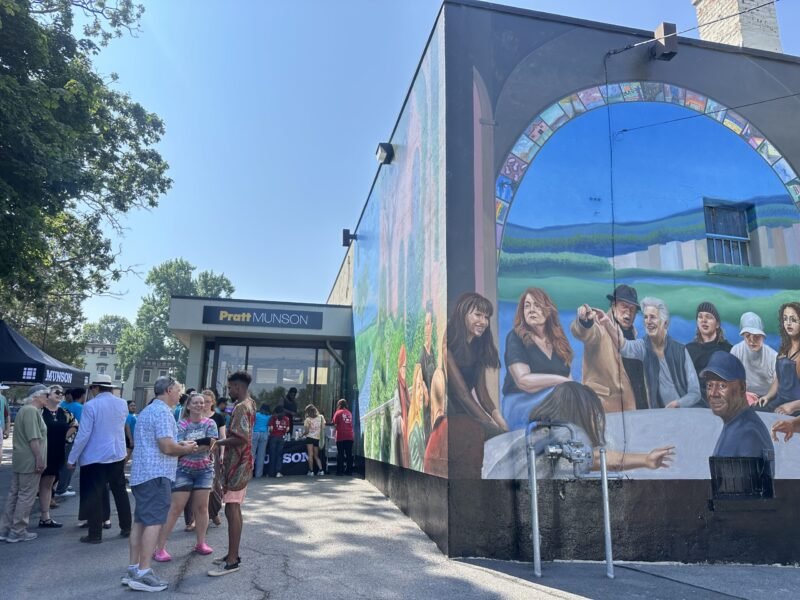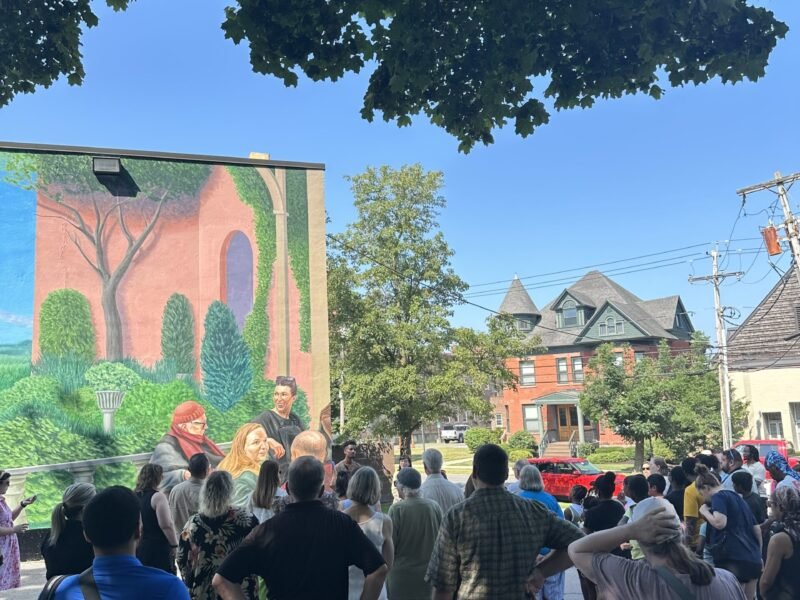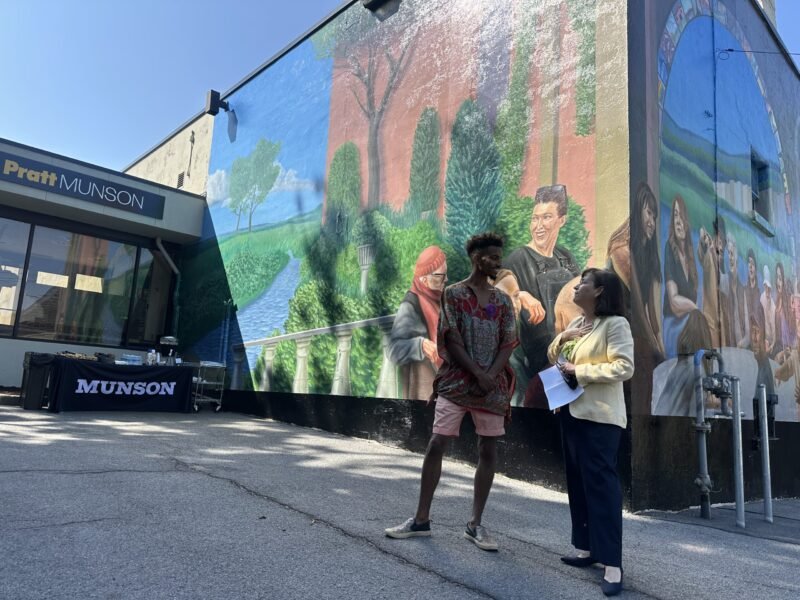Gathering in the Name of: One World Gathering” brings community together through art
The vibrant colors and powerful imagery of Utica’s newest mural are more than just artistic expression; they represent a community’s commitment to unity, diversity, and the transformative power of public art. The unveiling of “Gathering in the Name of: One World Gathering” at Munson’s Genesee Street Studio marks a significant moment in the city’s ongoing cultural renaissance and demonstrates how art can serve as a catalyst for community building and social cohesion.
This remarkable piece of public art arrives at a time when communities across America are grappling with questions of identity, belonging, and unity. In Utica, a city that has become a national model for refugee resettlement and multicultural integration, the mural serves as both a celebration of diversity and a call for continued cooperation among the city’s various communities.
The Power of Public Art
Public murals have long served as vehicles for community expression, historical documentation, and social commentary. They transform ordinary spaces into destinations, create gathering points for residents, and provide opportunities for dialogue about important issues. The “One World Gathering” mural continues this tradition while addressing contemporary challenges facing diverse communities.
The location at Munson’s Genesee Street Studio is particularly significant, as it places the mural in a space already dedicated to artistic expression and community engagement. This positioning ensures that the artwork will be part of an ongoing conversation about art, culture, and community rather than existing in isolation.
The mural’s title, “Gathering in the Name of: One World Gathering,” suggests both the physical act of coming together and the broader philosophical commitment to global unity. In a world often divided by political, cultural, and economic differences, this message of unity resonates particularly strongly in communities like Utica that have successfully integrated diverse populations.
Utica’s Cultural Renaissance
The unveiling of this mural represents another milestone in Utica’s remarkable cultural transformation. Over the past decade, the city has experienced a renaissance driven by new immigrant communities, urban renewal projects, and a growing recognition of the arts as an economic development tool.
The Refugee Resettlement Program has brought thousands of new residents to Utica from around the world, creating a multicultural environment that has challenged and enriched the city’s cultural landscape. These new residents have brought their own artistic traditions, culinary practices, and cultural celebrations that have helped revitalize neighborhoods and create new opportunities for cross-cultural exchange.
The mural project builds on this foundation of diversity while creating new opportunities for residents from different backgrounds to find common ground through shared artistic experiences. Art has the unique ability to transcend language barriers and cultural differences, making it an ideal medium for building bridges between communities.
Community Engagement and Participation
The success of public art projects often depends on the level of community engagement and participation in their creation and maintenance. The “One World Gathering” mural appears to have benefited from significant community input, ensuring that it reflects the values and aspirations of the residents it serves.
This collaborative approach to public art creation helps ensure that the final product resonates with community members and serves their needs rather than imposing external visions on local spaces. It also creates opportunities for residents to develop new skills, build relationships, and take ownership of their neighborhood’s aesthetic environment.
The involvement of local artists and community members in the mural’s creation provides economic benefits as well as cultural ones. These projects can provide income for local artists, training opportunities for aspiring creators, and experience in project management and collaboration that benefits participants long after the artwork is completed.
Economic Impact and Urban Development
Public art projects like the “One World Gathering” mural can have significant economic impacts on surrounding areas. They often serve as catalysts for additional investment, attracting businesses and residents who value cultural amenities and vibrant street life.
The mural’s location on Genesee Street, a major thoroughfare in Utica, ensures maximum visibility and potential impact on the surrounding business district. Visitors who come to see the mural may also patronize nearby restaurants, shops, and services, creating a multiplier effect that benefits the entire area.
Cultural tourism has become an increasingly important economic sector for cities like Utica, and public art installations serve as important attractions that can draw visitors from other regions. The mural joins other cultural assets in creating a destination experience that can support local tourism and hospitality industries.
Artistic Excellence and Technical Achievement
The technical execution of the “One World Gathering” mural represents a significant artistic achievement that deserves recognition alongside its cultural and social impacts. Creating large-scale public art requires specialized skills in design, color theory, weather resistance, and project management that not all artists possess.
The mural’s visual impact demonstrates the artist’s ability to create work that functions effectively at both intimate and distant viewing scales. The composition must work for pedestrians walking by as well as drivers passing at speed, requiring careful attention to form, color, and contrast.
The durability of the artwork is another crucial consideration, as public murals must withstand weather, pollution, and time while maintaining their visual impact. The selection of appropriate materials and techniques ensures that the investment in public art will continue to serve the community for years to come.
Cultural Representation and Inclusivity
The mural’s theme of “One World Gathering” suggests a commitment to representing the full diversity of Utica’s population in a way that celebrates difference while emphasizing common humanity. This approach to cultural representation requires sensitivity, research, and ongoing dialogue with community members from various backgrounds.
Effective multicultural art must avoid stereotypes and superficial representations while still acknowledging the distinct contributions of different cultural groups. The challenge is to create work that feels authentic to all communities while building bridges between them.
The success of such projects often depends on the ongoing relationships between artists and community members rather than one-time consultations. These relationships help ensure that the artwork continues to serve its intended purpose and remains relevant to changing community needs.
Educational Opportunities and Cultural Learning
Public murals serve important educational functions, providing opportunities for residents and visitors to learn about history, culture, and artistic techniques. The “One World Gathering” mural can serve as a starting point for discussions about diversity, immigration, cultural exchange, and the role of art in community building.
Schools and community organizations can use the mural as a teaching tool, incorporating it into lessons about art, social studies, and cultural awareness. These educational applications extend the mural’s impact beyond its immediate visual presence and help ensure that it contributes to ongoing learning and dialogue.
The mural also provides opportunities for intergenerational learning, as community elders can share their experiences and perspectives with younger residents while learning about contemporary artistic practices and cultural expressions.
Maintenance and Sustainability
The long-term success of public art projects depends on community commitment to maintenance and preservation. The “One World Gathering” mural will require ongoing attention to ensure that it continues to serve its intended purpose and maintains its visual impact over time.
Community ownership of the maintenance process can help ensure sustainability while providing ongoing opportunities for engagement and education. Volunteer programs, fundraising efforts, and educational activities can all contribute to the mural’s preservation while building community capacity.
The example set by this mural’s maintenance will likely influence future public art projects in Utica, establishing precedents for community involvement and responsibility that can support an expanding public art program.
Future Implications and Expansion
The success of the “One World Gathering” mural may inspire additional public art projects throughout Utica, creating a network of cultural assets that enhance the city’s livability and attractiveness. Strategic planning for future murals can help ensure that they complement existing work while addressing the needs of different neighborhoods and communities.
The skills and relationships developed through this project can serve as a foundation for future initiatives, creating a sustainable model for community-based public art that can be replicated in other locations. This approach to cultural development can help ensure that the benefits of public art are distributed equitably throughout the city.
Art as Community Builder
The “Gathering in the Name of: One World Gathering” mural represents more than just a beautiful addition to Utica’s streetscape; it embodies the city’s commitment to unity, diversity, and the power of art to bring people together. In a time when communities across America are searching for ways to bridge divides and build understanding, this mural provides a powerful example of how public art can serve as a catalyst for positive change.
The success of this project depends not just on its artistic merit but on the community’s ongoing engagement with its message and meaning. As residents and visitors encounter the mural in their daily lives, they are invited to reflect on their own roles in building a more inclusive and unified community.
The mural’s placement at Munson’s Genesee Street Studio ensures that it will be part of an ongoing conversation about art, culture, and community that extends far beyond the artwork itself. This integration into the city’s cultural ecosystem helps ensure that the mural’s impact will continue to grow and evolve over time.
For Utica, the “One World Gathering” mural represents another step in the city’s transformation from a post-industrial community struggling with decline to a vibrant, multicultural destination that offers lessons for other cities facing similar challenges. The mural stands as a testament to the power of art to inspire, unite, and transform communities willing to embrace their diversity as a source of strength.








